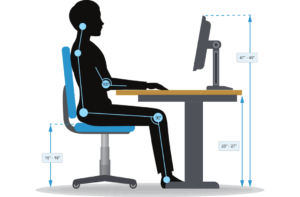Ergonomic Solutions to Improve Health and Safety at Work

In today’s modern workplaces, the health and safety of employees are paramount concerns for employers. With long hours spent at desks, repetitive tasks, and exposure to various hazards, it’s essential to implement ergonomic solutions that promote the well-being of workers and reduce the risk of injuries and illnesses. Ergonomics, the science of designing workplaces to fit the needs of workers, offers a range of solutions to address these concerns effectively. In this article, we will explore some ergonomic solutions to improve health and safety at work and their benefits for both employees and employers.
1. Ergonomic Workstation Design
One of the most fundamental aspects of ergonomics is the design of workstations to support the health and comfort of employees. An ergonomic workstation considers factors such as desk height, chair design, monitor placement, and keyboard and mouse positioning to minimize physical strain and prevent musculoskeletal disorders.
For example, adjustable desks and chairs allow employees to customize their workstation to their individual preferences and body dimensions, promoting good posture and reducing the risk of back and neck pain. Ergonomically designed chairs with lumbar support and adjustable armrests provide proper support and alignment for the spine, reducing the risk of ergonomic injuries.
2. Proper Equipment and Tools

In addition to workstation design, the selection of appropriate equipment and tools is essential for promoting health and safety in the workplace. Ergonomically designed tools and equipment reduce the physical effort required to perform tasks and minimize the risk of repetitive strain injuries.
For example, ergonomic keyboards and mice are designed to reduce wrist strain and prevent conditions such as carpal tunnel syndrome. Tools with padded handles and ergonomic grips reduce hand fatigue and improve grip strength, while adjustable-height workbenches and tool stands minimize bending and reaching motions, reducing the risk of back and shoulder injuries.
3. Training and Education
Another crucial aspect of promoting health and safety at work is providing employees with training and education on ergonomics principles and best practices. Educating employees on proper workstation setup, lifting techniques, and ergonomic awareness helps them identify and address potential ergonomic risk factors in their work environment.
For example, employees can learn about the importance of maintaining neutral postures, taking regular breaks, and performing stretching exercises to prevent muscle fatigue and discomfort. Training programs on ergonomics also empower employees to advocate for their own health and safety and identify opportunities for improvement in their work environment.
4. Environmental Modifications
In addition to individual workstation design and equipment, environmental modifications can also contribute to improved health and safety in the workplace. Factors such as lighting, temperature, air quality, and noise levels can all impact employee comfort and well-being.
For example, proper lighting reduces eye strain and fatigue, while adequate ventilation and air filtration systems promote indoor air quality and reduce the risk of respiratory issues. Noise-cancelling headphones or soundproofing materials can help reduce distractions and promote focus in noisy work environments.
5. Regular Ergonomic Assessments

Finally, regular ergonomic assessments of the workplace are essential for identifying potential hazards and implementing appropriate solutions. Ergonomic assessments involve evaluating workstations, tasks, and work processes to identify ergonomic risk factors and recommend interventions to mitigate them.
For example, ergonomic assessments may involve observing employees performing tasks, measuring workstation dimensions, and collecting feedback from workers about their comfort and satisfaction. Based on the findings of these assessments, employers can implement targeted interventions to address ergonomic issues and improve health and safety in the workplace.
In conclusion, ergonomics offers a range of solutions to improve health and safety at work, from workstation design and equipment selection to training and environmental modifications. By implementing ergonomic principles and best practices, employers can create work environments that promote the well-being of their employees and reduce the risk of injuries and illnesses. Investing in ergonomics not only benefits employees by enhancing comfort, safety, and productivity but also pays dividends for employers in terms of reduced absenteeism, turnover, and workers’ compensation costs.


